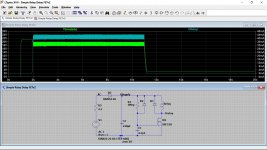Folks:
I rebuilt a chip amp this past summer (https://www.diyaudio.com/forums/chip-amps/79303-chip-amp-photo-gallery-171.html#post6695088, post #3403) which now consists of a Super Gain Clone amplifier and RJM Audio B-Board diamond buffers and it has been in service in my kitchen ever since. It does two troublesome things: about half the time it is turned on, a second or two later it turns itself off with a loud "thump". By that I mean the illuminated latching power switch actually reverts to its "off" state. The second thing is that when I turn the amp off, it invariably issues a loud thump as well.
Ghosts maybe? A cap across the power switch? Your counsel is appreciated.
Regards,
Scott
I rebuilt a chip amp this past summer (https://www.diyaudio.com/forums/chip-amps/79303-chip-amp-photo-gallery-171.html#post6695088, post #3403) which now consists of a Super Gain Clone amplifier and RJM Audio B-Board diamond buffers and it has been in service in my kitchen ever since. It does two troublesome things: about half the time it is turned on, a second or two later it turns itself off with a loud "thump". By that I mean the illuminated latching power switch actually reverts to its "off" state. The second thing is that when I turn the amp off, it invariably issues a loud thump as well.
Ghosts maybe? A cap across the power switch? Your counsel is appreciated.
Regards,
Scott
Attachments
If a latching power switch reverts to its off state... and if I'm interpreting what you say correctly... then the switch is faulty.
Do you mean it pops back out from an on position? or just becomes electrically open circuit and needing to be operated again to work.
Either way... faulty.
The thump is something that plagues many amps of all varieties and the only definite fix is normally a proper speaker relay disconnect circuit that drops out quickly on power off.
As a test if you power the amp up normally but then disconnect the power by other means (not using the amps on/off switch) such as pulling from the wall socket or using a wall switch then do you get the same noise?
If you do then you need the type of circuit mentioned.
Do you mean it pops back out from an on position? or just becomes electrically open circuit and needing to be operated again to work.
Either way... faulty.
The thump is something that plagues many amps of all varieties and the only definite fix is normally a proper speaker relay disconnect circuit that drops out quickly on power off.
As a test if you power the amp up normally but then disconnect the power by other means (not using the amps on/off switch) such as pulling from the wall socket or using a wall switch then do you get the same noise?
If you do then you need the type of circuit mentioned.
Mooly:
Yes, the thump persists if I unplug the power cable at the IEC connector. Thanks for the counsel -- I'll see if I can find a speaker relay disconnect board that will fit; there isn't much room left in the chassis.
Regards,
Scott
Yes, the thump persists if I unplug the power cable at the IEC connector. Thanks for the counsel -- I'll see if I can find a speaker relay disconnect board that will fit; there isn't much room left in the chassis.
Regards,
Scott
You might be able to get away with a super simple circuit to disconnect the speakers at power off.
Something like this. AC from the transformer is rectified and produces the rail to run the relay, however the small value of reservoir cap ensures the rail collapses very quickly on power off. It is totally tweakable to all kinds of voltages. It also gives a delay at power on.
Trace shows the AC voltage appear and disappear and corresponding DC rail (power on and power off) and the relay current.
Second image is a close up of the switch off point. Would that be fast enough? It is worth experimenting I think.
Something like this. AC from the transformer is rectified and produces the rail to run the relay, however the small value of reservoir cap ensures the rail collapses very quickly on power off. It is totally tweakable to all kinds of voltages. It also gives a delay at power on.
Trace shows the AC voltage appear and disappear and corresponding DC rail (power on and power off) and the relay current.
Second image is a close up of the switch off point. Would that be fast enough? It is worth experimenting I think.


